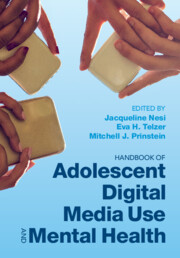16 results
Index
-
- Book:
- Handbook of Adolescent Digital Media Use and Mental Health
- Published online:
- 30 June 2022
- Print publication:
- 14 July 2022, pp 417-438
-
- Chapter
-
- You have access
- Open access
- HTML
- Export citation
Part IV - Intervention and Prevention in the Digital Age
-
- Book:
- Handbook of Adolescent Digital Media Use and Mental Health
- Published online:
- 30 June 2022
- Print publication:
- 14 July 2022, pp 363-416
-
- Chapter
-
- You have access
- Open access
- HTML
- Export citation
Part III - Digital Media and Adolescent Mental Disorders
-
- Book:
- Handbook of Adolescent Digital Media Use and Mental Health
- Published online:
- 30 June 2022
- Print publication:
- 14 July 2022, pp 215-362
-
- Chapter
-
- You have access
- Open access
- HTML
- Export citation
Tables
-
- Book:
- Handbook of Adolescent Digital Media Use and Mental Health
- Published online:
- 30 June 2022
- Print publication:
- 14 July 2022, pp x-x
-
- Chapter
-
- You have access
- Open access
- HTML
- Export citation
Part II - Digital Media in the Adolescent Developmental Context
-
- Book:
- Handbook of Adolescent Digital Media Use and Mental Health
- Published online:
- 30 June 2022
- Print publication:
- 14 July 2022, pp 61-214
-
- Chapter
-
- You have access
- Open access
- HTML
- Export citation
Contents
-
- Book:
- Handbook of Adolescent Digital Media Use and Mental Health
- Published online:
- 30 June 2022
- Print publication:
- 14 July 2022, pp vii-viii
-
- Chapter
-
- You have access
- Open access
- HTML
- Export citation
Acknowledgments
-
- Book:
- Handbook of Adolescent Digital Media Use and Mental Health
- Published online:
- 30 June 2022
- Print publication:
- 14 July 2022, pp xv-xvi
-
- Chapter
-
- You have access
- Open access
- HTML
- Export citation
Introduction
-
- Book:
- Handbook of Adolescent Digital Media Use and Mental Health
- Published online:
- 30 June 2022
- Print publication:
- 14 July 2022, pp 1-6
-
- Chapter
-
- You have access
- Open access
- HTML
- Export citation
Dedication
-
- Book:
- Handbook of Adolescent Digital Media Use and Mental Health
- Published online:
- 30 June 2022
- Print publication:
- 14 July 2022, pp v-vi
-
- Chapter
-
- You have access
- Open access
- HTML
- Export citation
Part I - Theoretical and Methodological Foundations in Digital Media Research and Adolescent Mental Health
-
- Book:
- Handbook of Adolescent Digital Media Use and Mental Health
- Published online:
- 30 June 2022
- Print publication:
- 14 July 2022, pp 7-60
-
- Chapter
-
- You have access
- Open access
- HTML
- Export citation
Contributors
-
- Book:
- Handbook of Adolescent Digital Media Use and Mental Health
- Published online:
- 30 June 2022
- Print publication:
- 14 July 2022, pp xiii-xiv
-
- Chapter
-
- You have access
- Open access
- HTML
- Export citation
About the Editors
-
- Book:
- Handbook of Adolescent Digital Media Use and Mental Health
- Published online:
- 30 June 2022
- Print publication:
- 14 July 2022, pp xi-xii
-
- Chapter
-
- You have access
- Open access
- HTML
- Export citation
Copyright page
-
- Book:
- Handbook of Adolescent Digital Media Use and Mental Health
- Published online:
- 30 June 2022
- Print publication:
- 14 July 2022, pp iv-iv
-
- Chapter
-
- You have access
- Open access
- HTML
- Export citation
Figures
-
- Book:
- Handbook of Adolescent Digital Media Use and Mental Health
- Published online:
- 30 June 2022
- Print publication:
- 14 July 2022, pp ix-ix
-
- Chapter
-
- You have access
- Open access
- HTML
- Export citation

Handbook of Adolescent Digital Media Use and Mental Health
-
- Published online:
- 30 June 2022
- Print publication:
- 14 July 2022
-
- Book
-
- You have access
- Open access
- Export citation
Emotion dysregulation and non-suicidal self-injury: A systematic review and meta-analysis
-
- Journal:
- European Psychiatry / Volume 59 / June 2019
- Published online by Cambridge University Press:
- 01 January 2020, pp. 25-36
-
- Article
-
- You have access
- HTML
- Export citation



